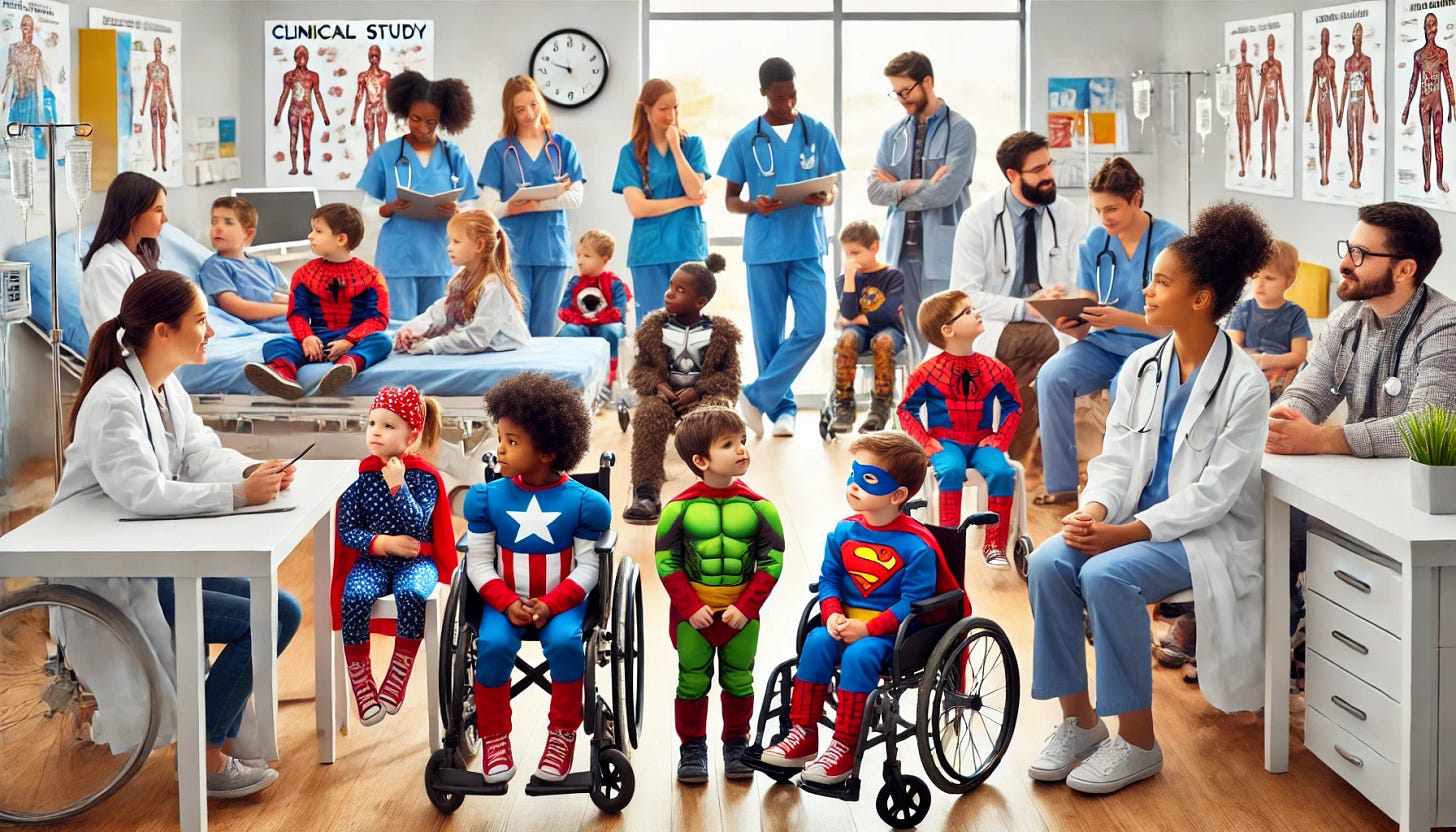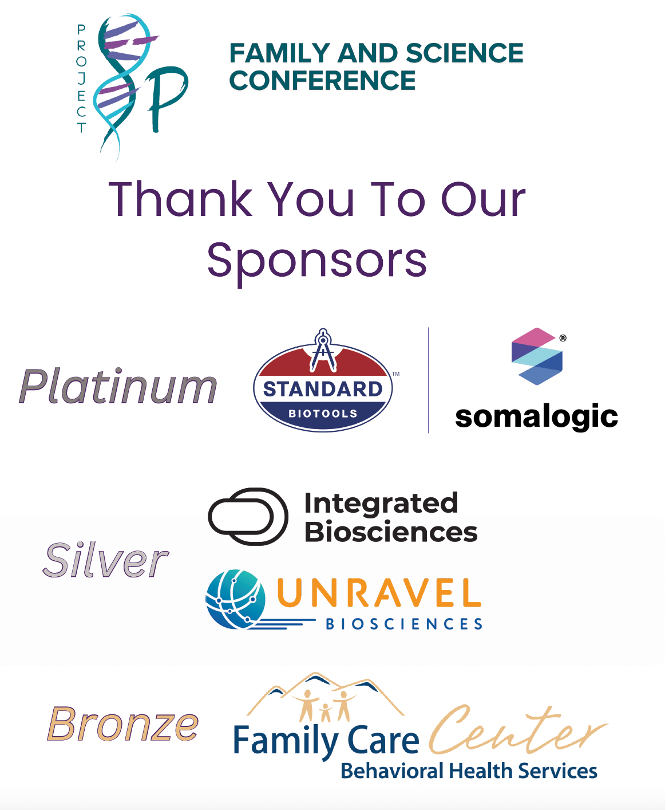8p Health Canvas Explainer
The 8p Health Canvas is the clinical version of a group photo. A wide-angled snapshot of 8p heroes and their disease progression that sets the stage for future clinical trials.
In the Summer Research Newsletter published last week, I previewed the agenda and invited speakers for the 2024 8p Family & Science Conference, which kicks off today in Denver Colorado. The entire Project 8p team has meticulously planned this meeting since the start of the year, assembling a special group of stakeholders in one location. Notably, over 30 8p heroes and their families will be in attendance, the largest 8p community gathering to date.
On behalf of the Project 8p science team, I present the rationale for leveraging the 2024 8p Family & Science Conference as a popup clinical research site for a hypothesis generating, cross-sectional study to assess nutritional status, bioenergetics (mitochondrial) dysfunction, protein markers of inflammation, gene expression patterns, metabolite levels, and gut microbiome composition in 8p heroes.
Or what we have dubbed the 8p Health Canvas.
Technically, the 8p Health Canvas is a turbocharging of the ongoing IRB-approved, Project 8p-sponsored protocol that established a patient registry (database) of a geographically dispersed population of 8p heroes, the ability to contact (and recontact) 8p families with medical surveys, and a biobank containing cryopreserved cell lines and biosamples derived from 8p heroes.
This protocol, originally approved in 2019, can be considered the precursor to a proper natural history study. Project 8p previously leveraged the 2021 Moving Mountains conference as a popup site for biospecimens collection.
The 8p Health Canvas core team is comprised of three individuals. The Principal Investigator is Bina Maniar, the founder and CEO of Project 8p and mom to 8p hero Karina. I serve as the Study Director. Kaiti Syverson, Project 8p’s patient engagement manager and mom to 8p hero Chloe, serves as the Study Coordinator. Dr. Richard Frye, M.D., Geri Brewster, RD MPH CDN, serve as clinical advisors with a focus on mitochondrial dysfunction and nutritional optimization, respectively.
Stepping back, the 8p Health Canvas project has three strategic objectives: (1) perform a real-world IRB-approved clinical research study that prepares the 8p community for repurposed and novel therapies currently in discovery and preclinical development; (2) generate hypotheses about disease-driver mechanisms and biomarkers and how best to stratify 8p heroes based on measurable genotype-phenotype relationships; (3) promulgate best-practices guidelines for the use of over-the-counter nutritional interventions that can ultimately be published in a peer-reviewed journal.
What does that practically mean for 8p heroes? We hope to identify the first treatment options for 8p through drug repurposing, the process of finding a new use for an old medicine. In parallel, we hope to discover biomarkers (outcome measures) that will prove that a given intervention is working or not. We also hope to match 8p heroes with appropriate treatments based on their likelihood of responding aka hero stratification.
In the run-up to Denver, Project 8p disseminated medication and supplement surveys to the 161 8p families in the Project 8p registry. These survey results will constitute nutritional baselines which will be reviewed by Project 8p’s science team in consultation with the 8p Health Canvas clinical advisors. Over the span of two days at the conference, we will collect consented biospecimens from 8p heroes for a suite of assessments that I will describe in greater detail below.
After the conference, what began as a single wide-angled snapshot will transition into a time-lapse panorama: a longitudinal natural history study led by physician scientists that will track an expanding cohort of 8p heroes over time. This next phase will be done in collaboration with the Colorado Children’s Hospital’s 8p clinical care team.
If data from the cross-sectional study support it, an optional third phase (potentially requiring both IRB and IND approvals) would consist of an open label, baseline-controlled, multi-week interventional study in the population of 8p heroes that demonstrates measurable phenotypic defects that can be rationally expected to be modified by existing nutraceuticals or probiotics or over-the-counter repurposed drugs.
We are in part modeling the Health Canvas after Dr Richard Frye’s experience with Phelan-McDermid Syndrome (PMS) with the hopes of identifying over-the-counter, supplement-based interventions that could be rapidly translated to the clinic. Several mitochondrial genes are deleted in PMS, creating a rational basis for investigating mitochondrial function in living patients using easy-to-use buccal swabs.
In addition to the fact that several mitochondrial genes are also affected in 8p chromosome disorders, in vitro studies on four 8p fibroblasts lines by Prof Nicoleta Moisoi’s lab previously revealed a decrease in mitochondrial membrane potential, providing further evidence of secondary mitochondrial dysfunction as a potential contributor to pathophysiology in 8p chromosome disorders.
We also draw inspiration from our friends in the Angelman Syndrome (AS) community. Below is an example of AS longitudinal natural history study data. Each of the traces represents a single AS patient. Longitudinal data like this will ultimately enable 8p hero stratification and allow us to deeply understand each 8p hero’s biology so we can tailor therapeutic opportunities accordingly. Those data will also enable the generation of a synthetic placebo group for comparisons to active treatment groups in future clinical trials.

The 8p Health Canvas will assess 8p heroes across seven dimensions using validated testing platforms. This systematic workup mirrors the flow of biology’s Central Dogma from DNA to RNA to protein to metabolites. It also captures physiological outputs like mitochondria function and gut microbiome composition.
Illumina will perform whole-genome sequencing (WGS) and and gene expression profiling (RNAseq) on peripheral blood mononuclear cells (PBMCs), and Alamya Health will complete DNA methylation analysis. Unravel Biosciences will perform RNAseq on nasal swabs. Somalogic’s SomaScan platform enables proteomics on over 7,000 serum proteins. Metabolomics on blood will be conduced by Metabolon. Religen’s buccal (cheek) MitoSwab test measures the activity of mitochondrial electron-transport chain complexes. Finally, the GI MAPS test by Diagnostic Solutions Laboratory (DSL) will reveal gut microbiome composition from stool samples.
All of these assessments are in the service of 8p hero stratification. Unravel Biosciences, Religen and DSL have the potential to yield drug repurposing candidates. Somalogic and Metabolon have the potential to surface quantitative biomarkers.
In conclusion, we’d like to thank our generous corporate and in-kind sponsors, in particular Somalogic, Unravel Biosciences and Illumina. We also appreciate discounted nonprofit pricing offered by Somalogic, Religen and DSL.
Onward toward the clinic for 8p!








This looks wonderful, thank you Bina, Kaiti, Ethan and all Project 8p Researchers. Hope you are having a wonderful time at the conference.